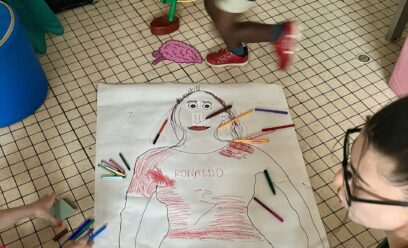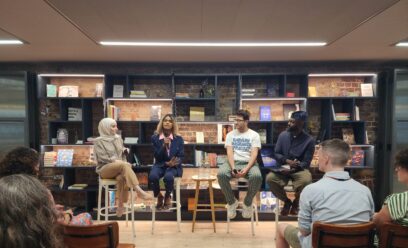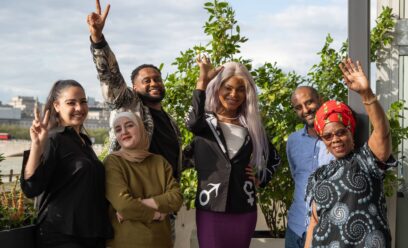From bad taste to The Nobel Peace Prize
Posted by IMIX on December 8, 2020IMIX media director, Denise Meredith, on what she learned about managing media from working on a Nobel Prize winning campaign

When I was a press officer for the Red Cross, I worked on an issue few people had heard about back in the nineties. When a journo rang me up to talk about the latest breaking story in Bosnia, I would tell them what they needed to hear and then change the conversation and whether they wanted to listen or not – brief them on the campaign I was running with a colleagues at The Halo Trust and Mines Advisory Group. The issue of land mines where the death tally was higher and the impact on people’s lives just as devastating as any war. But where the killing continued long after the soldiers and press corp had left.
Millions of mines were strewn in the fields and rivers of long forgotten conflicts in places like Afghanistan and civilians were paying the price. Farmers were losing limbs as they tilled the fields. Children were losing their lives as they crossed a field to tend to their cattle. Or as they picked up a mine thinking it was a toy – shaped like a butterfly or disguised in a little girl’s doll. Adults maimed or made blind – their lives devastated by the brutality of landmines – this terrible legacy of war. But back then the UK press didn’t know about the issue. And the politicians wanted us to be quiet. There was too much money at stake for the arms manufacturers – one of the companies making components for these terrible weapons being British.
After a year or so of intense lobbying that landmines mattered, I managed to persuade a number of journalists to cover this so-called non-news story – John Simpson who went to the besieged city of Kabul (a country littered with seven million mines) and a leading tabloid to Cambodia where war had long ended but skirmishes continued up on the Thai border and where millions of mines still polluted the paddy fields- the other killing fields.
I spent three long arduous weeks travelling across Cambodia. I used up a huge amount of my colleagues time and energy to break the story – prosthetics experts, war surgeons, de-miners from The Halo Trust, nurses, drivers, translators and security experts (the country was still highly volatile). I set up interviews with families who had lost children. With the children themselves who were learning to walk again on prosthetic limbs. It was traumatic, dangerous and exhausting work for all who were involved but we had to tell the story. We had to get the issue into the public eye.
John Simpson delivered with a one-hour special on BBC Newsnight. Not game changing but in the end -as part of overall drip feed- vital. My own trip to Afghanistan with The Times and ITN also made a bit of dent into the public consciousness (tiny, fleeting) but the piece I really needed to secure was in a mass market publication. A so called red top. After months of persuasion, a tabloid team finally joined me on the trip to Cambodia. And I will never forget when the call came through from the journalist who accompanied me on the trip the day after we got back and the editor saw the piece.
“It’s not going to run,” she said, her voice strangulated. Strange.
Three weeks of work. Three weeks in the field involving all those people? All those children who allowed us to talk to them as they recovered in hospital? All those desperate parents who thought we’d come to help? All those Red Cross doctors and nurses I had to beg to help me?
“What do you mean? I don’t understand. This week? Next week?” I just couldn’t get my head round it. I felt sick.
“Not ever. The editor said to me.”
“What…what did they say?”
There was a pause.
Her voice was tight but she told me straight, “Nobody wants to look at pictures like that over their cornflakes. It’s bad taste. That’s what he said. I’m so incredibly sorry.”
It was the last time I let that journalist anywhere near the work of the Red Cross. And I was left to explain to my colleagues how we had wasted their time and resources. How I had offered to take these stories to the world only to let everybody down. But I learnt a hard lesson about media relations.
Good stories, no matter how worthy, can take a huge amount of time and effort to break through the white noise. You are competing against a million other stories, personal prejudices of editors and media owners and audience perceptions.
There is no quick route to a campaign success. Campaigning takes time. Resolve. Dedication.
Editors decide. Not charities or causes about what is a media worthy story and what isn’t. Why a story runs or why it doesn’t. The news agenda can kill your story. If something big breaks: the queen is dead, a nuclear explosion at Sellafield, your story no matter how much you have planned, how much effort your charity has put in, will be wiped off the schedule. News is news for a reason – its fast moving and ever changing.
When it comes to issue based campaigning, we need the media more than they need us.
It’s worth remembering this when we have set up a story which has taken us time and then is dropped. It happens all the time. But I would urge you to continue to develop story ideas. Every interaction with the journalist teaches you more about media relations. You start to learn about how news editors think – they care about their readers – more than they do your cause. They care about circulation figures, their bosses, surviving. So make your story so incredible they cannot say no. Find angles. Recruit big names. Build your relationship with a small cohort of media – if the story you plan doesn’t make it first time- dust yourself down and try again. Don’t give up. And getting a piece in is always a cause for celebration.
This is what I learnt. The issue of landmines was not only complex, it proved to be a difficult sell. Audiences at that time were unused to graphic images. The injuries caused by landmines were violent, gory and distressing.
But we carried on. We chose our targeted media more carefully – journalists who had empathy. I found reporters who had lost colleagues when a roadside mine had gone off (the FT and Sky News). I found journalists who had children the same age as the children I told them about (the BBC). We recruited celebrities. I found this difficult. It felt like ‘bad taste’ to me. But we had to – we had no choice. We had to, cynically and disturbingly, make this violence palatable.
Right now it’s Marcus Rashford on food poverty. Back then, we persuaded Princess Diana to go to Angola and walk through a de-mined mine field. Suddenly the landmines issue wasn’t unpleasant anymore. The world’s press was beating down our door, begging us to be on the trip, for interviews and photos. It was front-page, world-stage news. The landmines campaign went on to win the Noble Peace Prize. But more importantly, The Ottawa Convention was signed by over 200 signatories agreeing to control the use of landmines mines. After six years of hard graft, the campaign was considered to be a huge success.
I was glad to have played my part, proud to have worked for the Red Cross and on an issue which I cared about deeply – but it also made me highly cynical about the motives of many mass market and tabloid editors. It taught me some hard lessons about how media relations works. It’s not a quick fix. It doesn’t come easy. It is not paid-for PR. No matter how much time you invest or your charity invests, there are no guaranteed results. But stick with it, and you can have a massive impact.
For more insights into working with the press, take a read of Denise’s next blog, 10 top tips for managing media relations.



